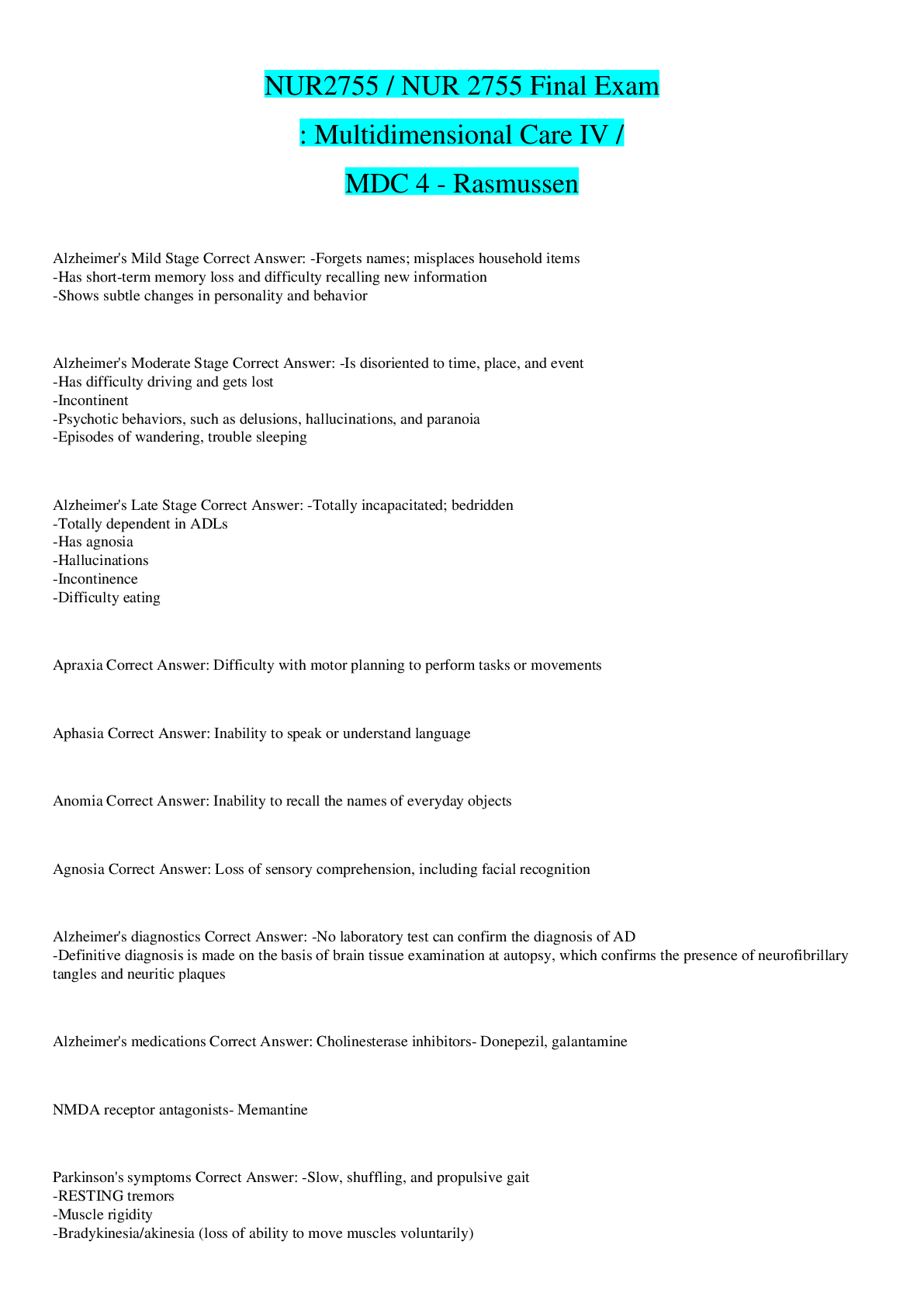Health Care > EXAM > NUR2755 / NUR 2755 Final Exam Kahoot (Latest 2021 / 2022): Multidimensional Care IV / MDC 4 - Rasmus (All)
NUR2755 / NUR 2755 Final Exam Kahoot (Latest 2021 / 2022): Multidimensional Care IV / MDC 4 - Rasmussen
Document Content and Description Below
MDC4 Exam 1 Kahoots! Meaghan Harvley’s Kahoot 1. Alzheimer’s disease is a rapid, reversible brain disease. t/f a. False—slow, progressive, irreversible 2. The patient can eat solid foods for... up to 2 hours before their procedure/surgery. t/f a. False—6-8 hours of NPO before a procedure 3. What are the cardinal signs of PD? a. Tremors b. Muscle rigidity c. Shuffling gait/postural instability d. Bradykinesia 4. In the severe stages of PD, the pts arms are affected, shuffling gate and they have a mask-like face. t/f a. False—in the mild stage this occurs 5. With migraines, if an aura is present, it includes visual changes, flashing lights, colors? t/f a. True 6. Generalized seizures involve both cerebral hemispheres. t/f a. True 7. In the ictal phase of a seizure, what should the nurse do first? a. Maintain the airway by turning the pt on their side. 8. What is the preferred medication to admin during a seizure? a. Lorazepam 9. Status epilepticus is not a life-threatening t/f a. False 10. Viral meningitis has a high fatality rate, even with tx, typically within 24-48 hours. T/f a. False—bacterial meningitis is highly fatal 11. Progressive relapsing MS (PRMS) includes frequent relapses with only partial recovery. t/f a. True 12. Signs of ALS include: progressive weakness and wasting in the hands and limbs, then upper arms and shoulders. t/f a. True 13. Hyperextension is sudden and extreme movement of the head forward causing extreme flexion of the neck. t/f a. False—hyper reflection is a sudden and extreme movement of the head forward causing extreme flexion of the neck. b. Hyperextension is an accelerated and then decelerated movement of the head. Associated with motor vehicle accidents from the rear. 14. With incomplete (paresis), the spinal cord has been damaged so at there so no innervation below the level of injury. t/f a. False—incomplete means the ability of the spinal cord to convey messages to or from the brain is not completely lost. Some sensation (even if faint) and movement is possible below the level of injury. 15. Autonomic dysreflexia is a sudden, potentially life-threatening occurrence in patients with SCIs. t/f a. True NUR2755 / NUR 2755 Final Exam Kahoot (Latest 2021 / 2022): Multidimensional Care IV / MDC 4 - Rasmussen MDC4 Exam 1 Kahoots! 16. A CVA affects opposite sides of the body. t/f a. True 17. An ischemic stroke involves bleeding in and around the brain tissue. t/f a. False. A hemorrhagic stoke involves bleeding. 18. With an ischemic stroke, embolic plaques can break loose and occlude vessels. t/f a. True 19. The “thunderclap” headache is common with intracerebral hemorrhage (ICH). t/f a. False—occurs with no hemorrhage. 20. Left hemisphere stroke, is dominant in most pts, center for language, math, and analysis. T/f a. True 21. Receptive aphasia is referred to as “Broca’s” or motor, aphasia. t/f a. False—receptive aphasia is referred toas Wernicke’s aphasia, able to speak well and use long sentences, but what is said may not make sense. b. Broca’s aphasia or expressive aphasia, partial loss of the ability to produce language (spoken, manual, or written) 22. Nystagmus involves involuntary movements of the eyes (can be vertical or horizontal). t/f a. True 23. Interventions for pts experiencing strokes are determined primarily by the type and extent of the stroke. t/f a. True 24. Alteplase (tPA) is primarily given for hemorrhagic stroke. t/f a. False—tPA is a clot buster, therefore it is contraindicated for bleeding disorders. 25. What is the time for admin tPA? a. Within 3 hours. No longer than 4.5 hours after onset of symptoms 26. What is the acronym used for quick assessment if a stroke is occurring? a. BEFAST i. B: balance; watch for sudden loss of balance ii. E: eyes; check for vision loss iii. F: face; look for an uneven smile iv. A: arm; check if one arm is weak v. S: speech; listen for slurred speech vi. T: time; call 911 right away 27. Indirect injury involved a force produced by a blow to the head. t/f a. False—an indirect injury is a gunshot wound 28. With a closed injury, the skull is fractured/pierced by a penetrating object. t/f a. False—this would be an open injury because the skin would be broken 29. The most common secondary injuries are hypotension and hypoxia, intracranial hypertension, and cerebral edema. t/f a. True 30. What is the normal level for ICP? a. 10-15 mmHg—should not exceed 20 mmHg 31. A subdural hematoma results from arterial bleeding into the space between the dura and the inner skull. t/f a. False—this is an epidural hematoma or an extradural hematoma. MDC4 Exam 1 Kahoots! b. A subdural hematoma is venous bleeding into the space beneath the dura and above the arachnoid from a tearing of the bridging veins within the cerebral hemispheres or from a laceration of brain tissue. 32. Chronic SDH presents within 48 hours after impact. t/f a. False—An acute SDH presents within 48 hours after impact; Subacute SDH presents between 48 hours and 2 week; Chronic SDH presents from 2 weeks to several months after injury 33. Primary tumors originate within the CNS and rarely metastasize (spread) outside this area. t/f a. True 34. Benign tumors require more aggressive intervention, including surgery, radiation, and/or chemotherapy. t/f a. False-malignant tumors require more aggressive therapy 35. Cerebral tumors involve hearing loss, nystagmus, ataxia, and dysarthria. t/f a. False—brainstem tumors involve the above s/s and more (dysphagia, hoarseness, apnea, bradycardia, hypotension b. Cerebral tumors involve headaches (most common feature), vomiting, seizure, changes in visual acuity and visual fields, diplopia, hemiparesis or hemiplegia, hypokinesia (decreased motor ability), hyperesthesia, paresthesia, decreased tactile discrimination, aphasia, and changes in personality or behavior. 36. Cushing’s Triad indicated decreasing ICP. t/f a. False—indicates increased ICP 37. What is most important variable to assess with brain injury? a. Level of consciousness 38. As with any critically injured patient, priority is given to maintaining a patent airway, breathing, and circulation. t/f a. True 39. What is the first priority of pre-op nurse? a. Witnessing informed consents—sign the consent as a witness to the signature, not to the fact that the client is informed. 40. Post op nausea and shivering occurs with local/regional anesthesia. t/f [Show More]
Last updated: 1 year ago
Preview 1 out of 15 pages
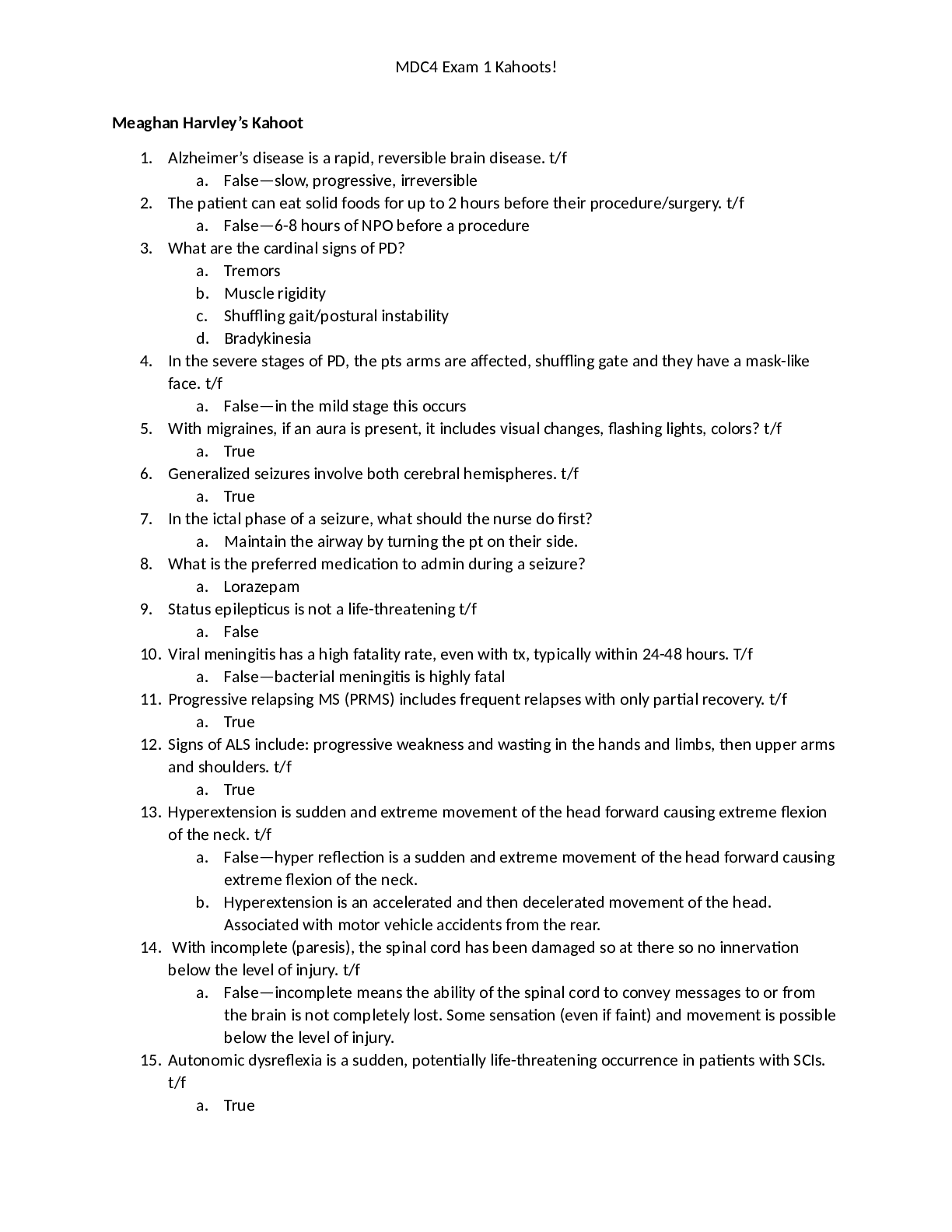
Reviews( 0 )
Document information
Connected school, study & course
About the document
Uploaded On
Jul 28, 2022
Number of pages
15
Written in
Additional information
This document has been written for:
Uploaded
Jul 28, 2022
Downloads
0
Views
40

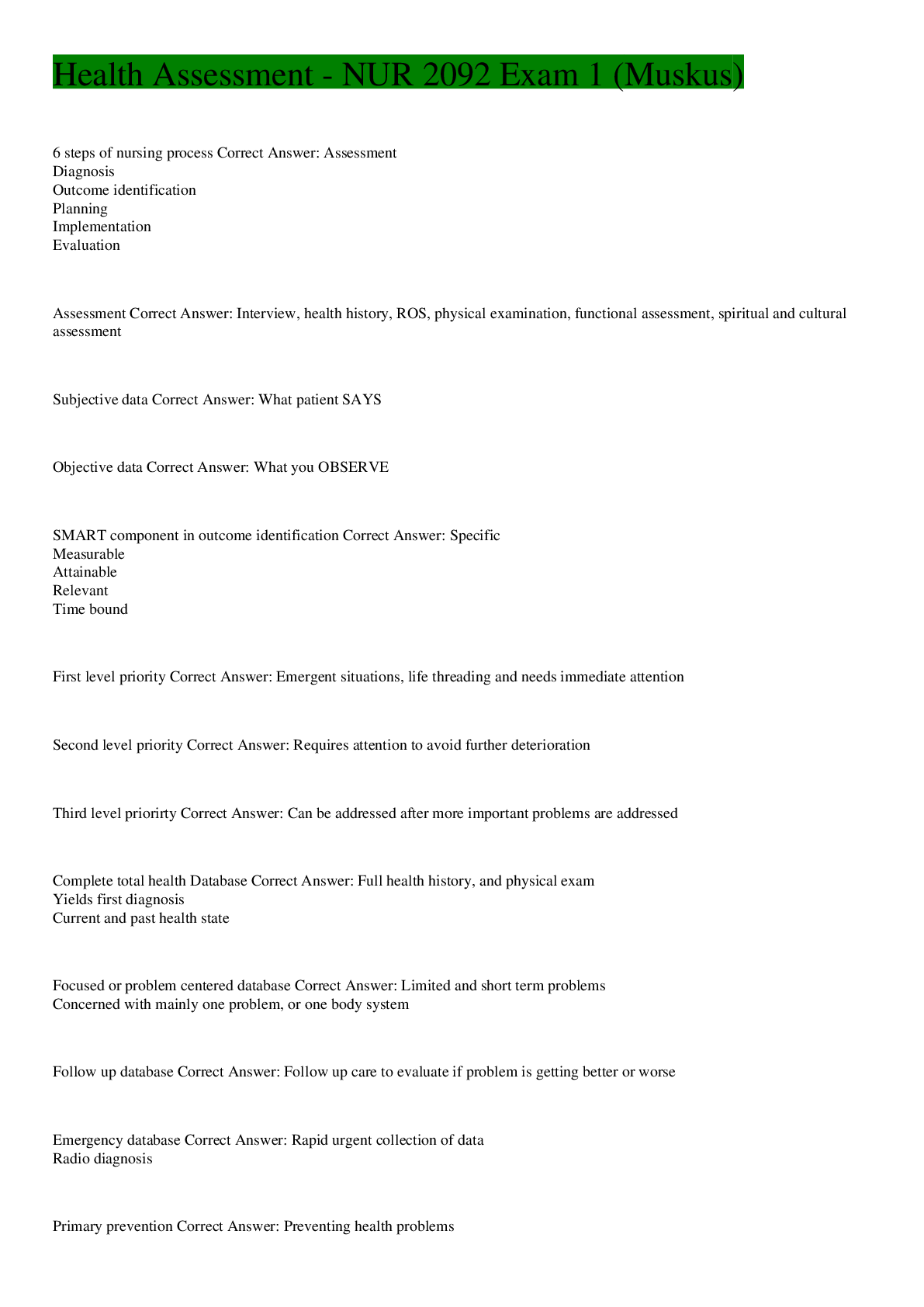
.png)
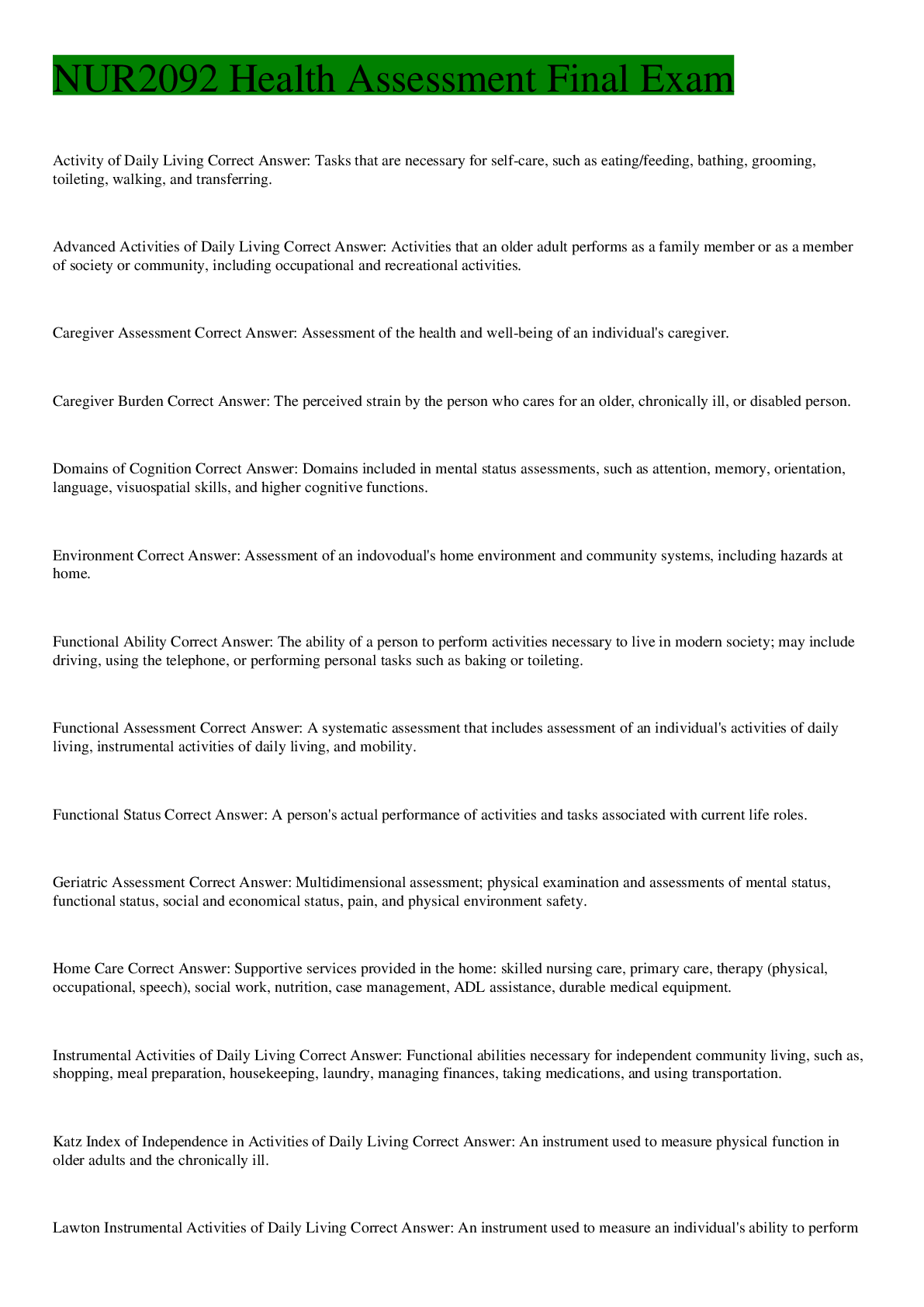
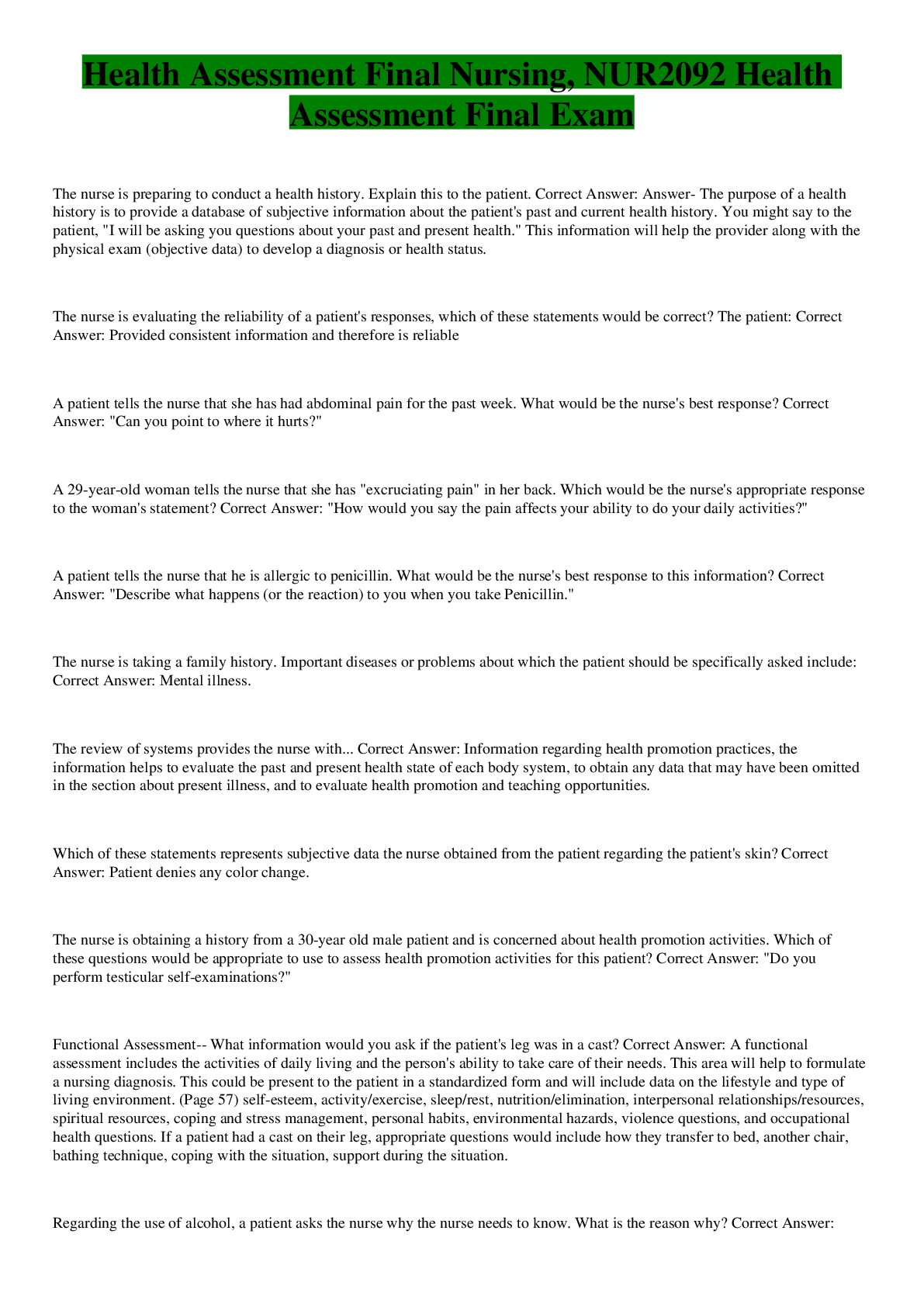
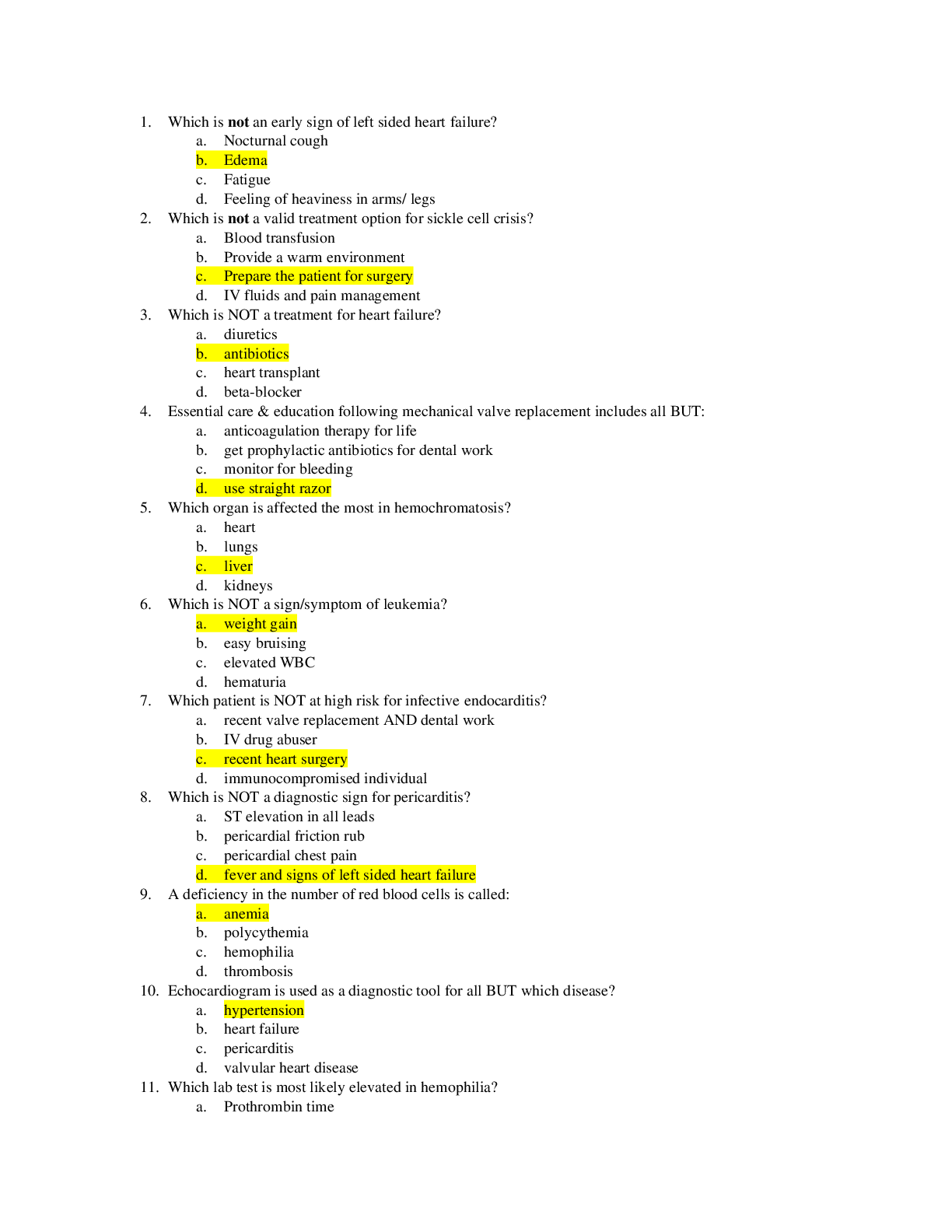
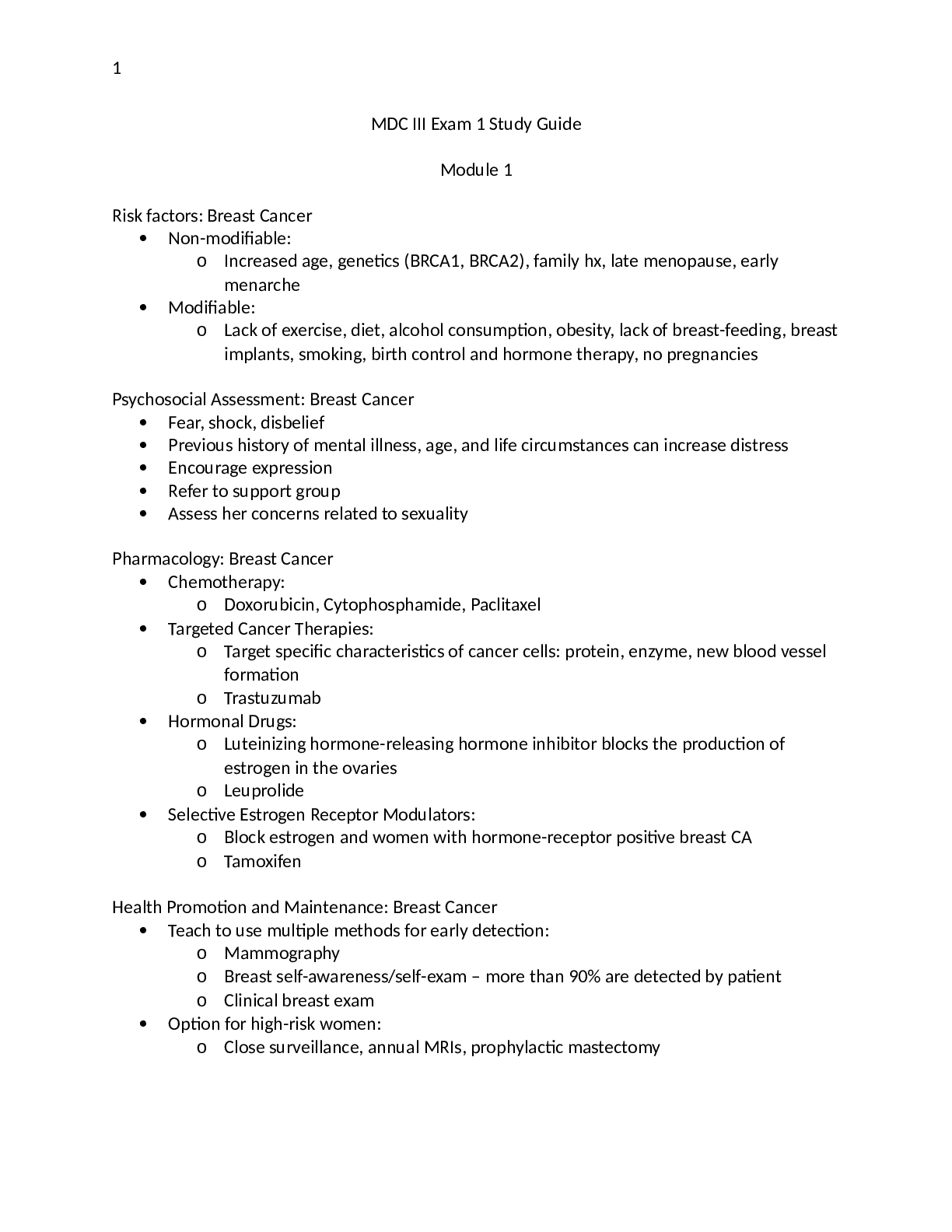

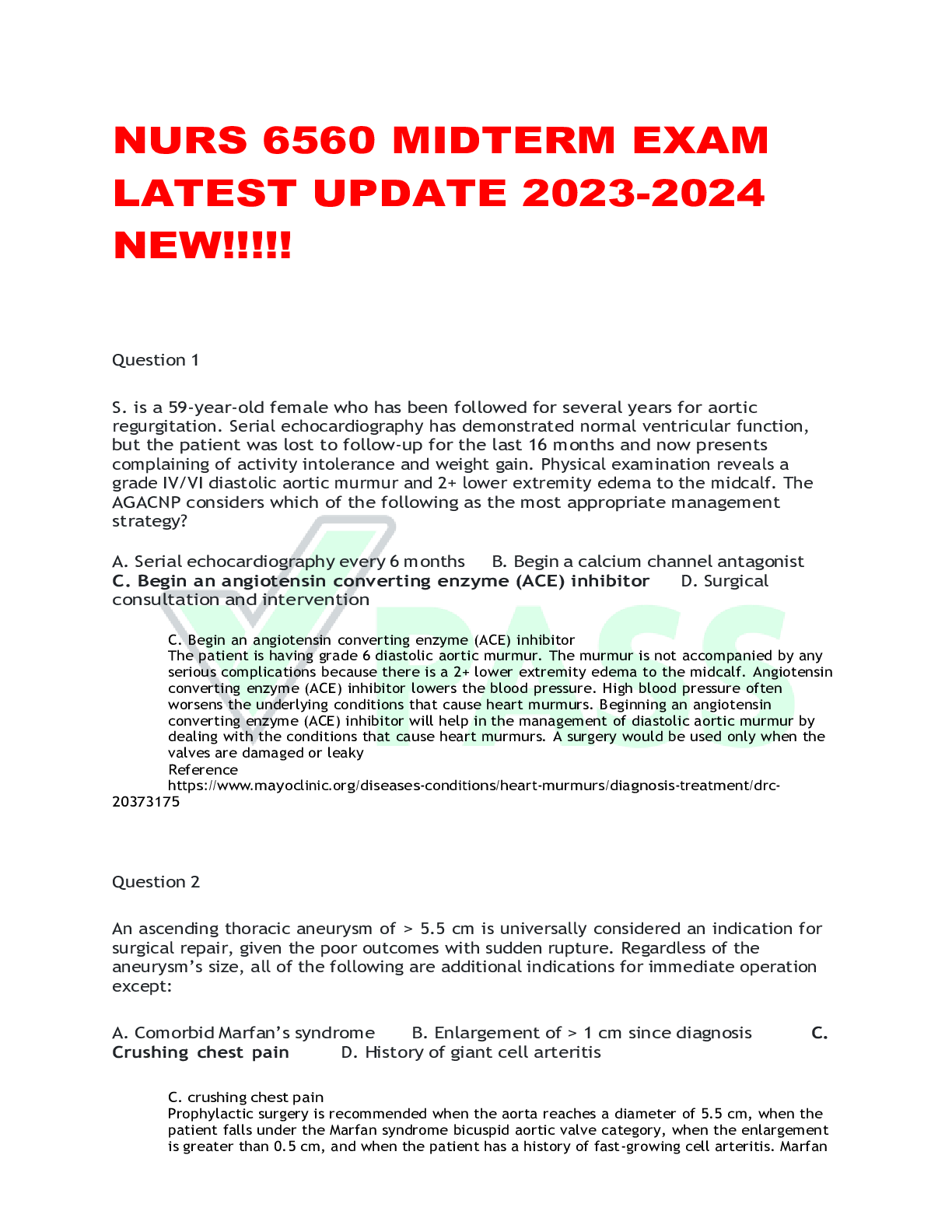
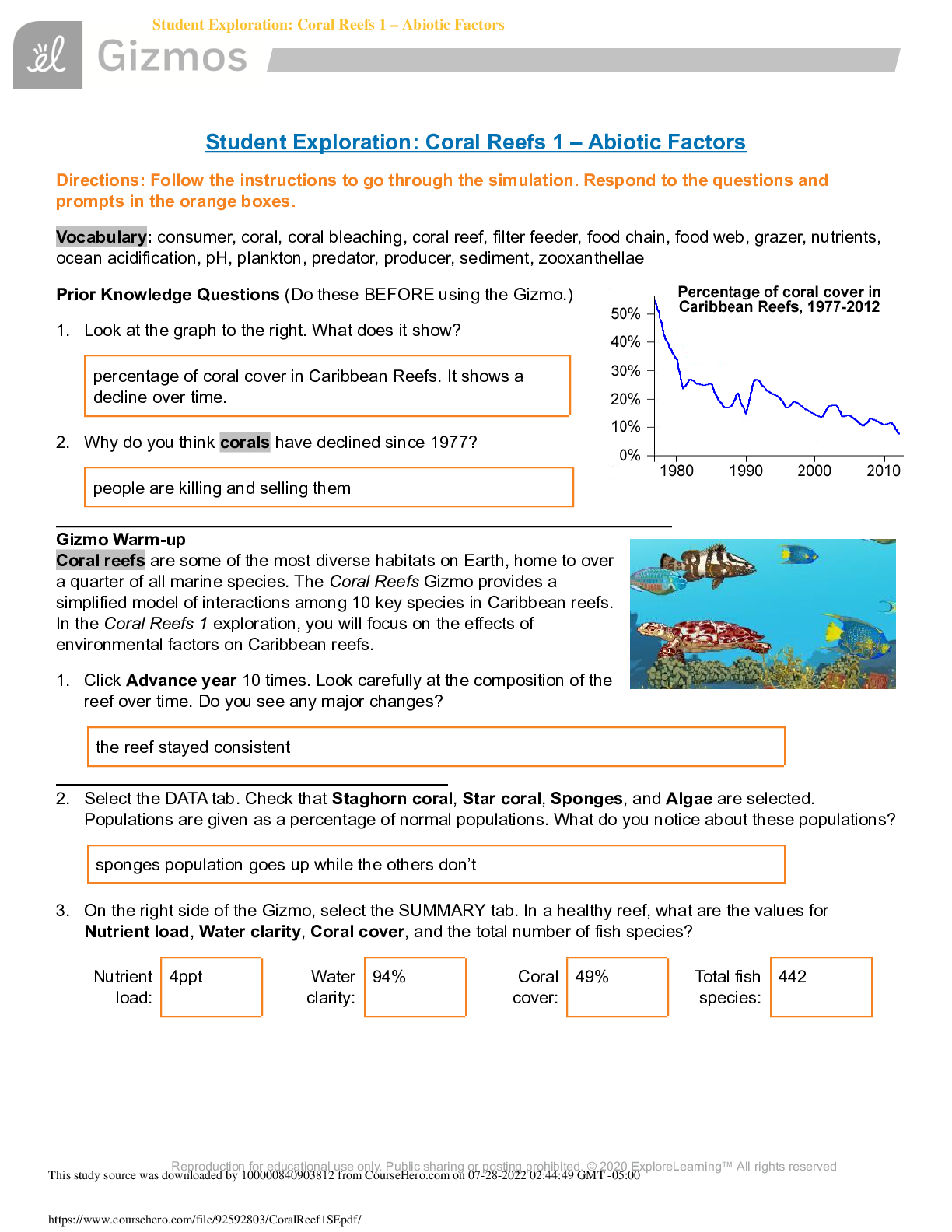
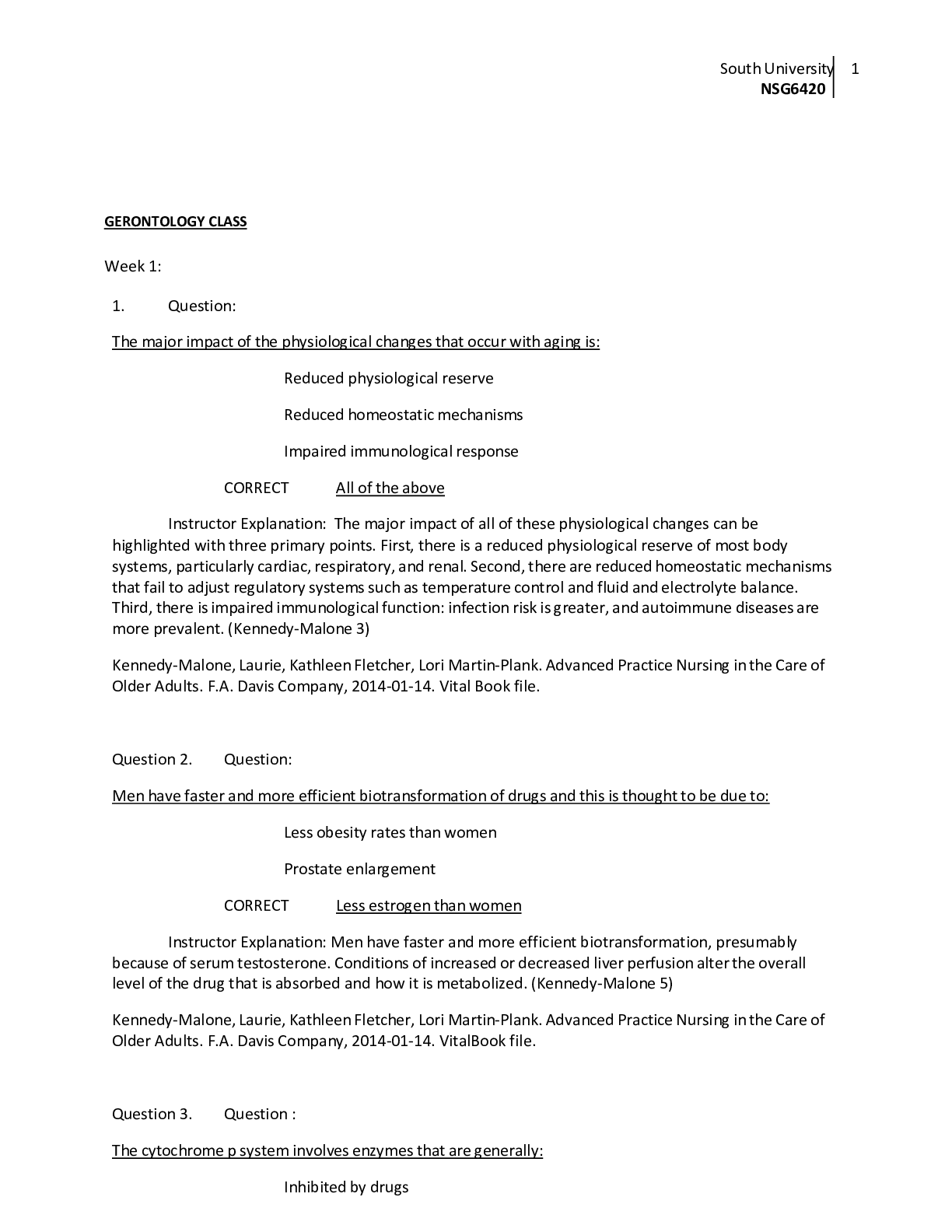
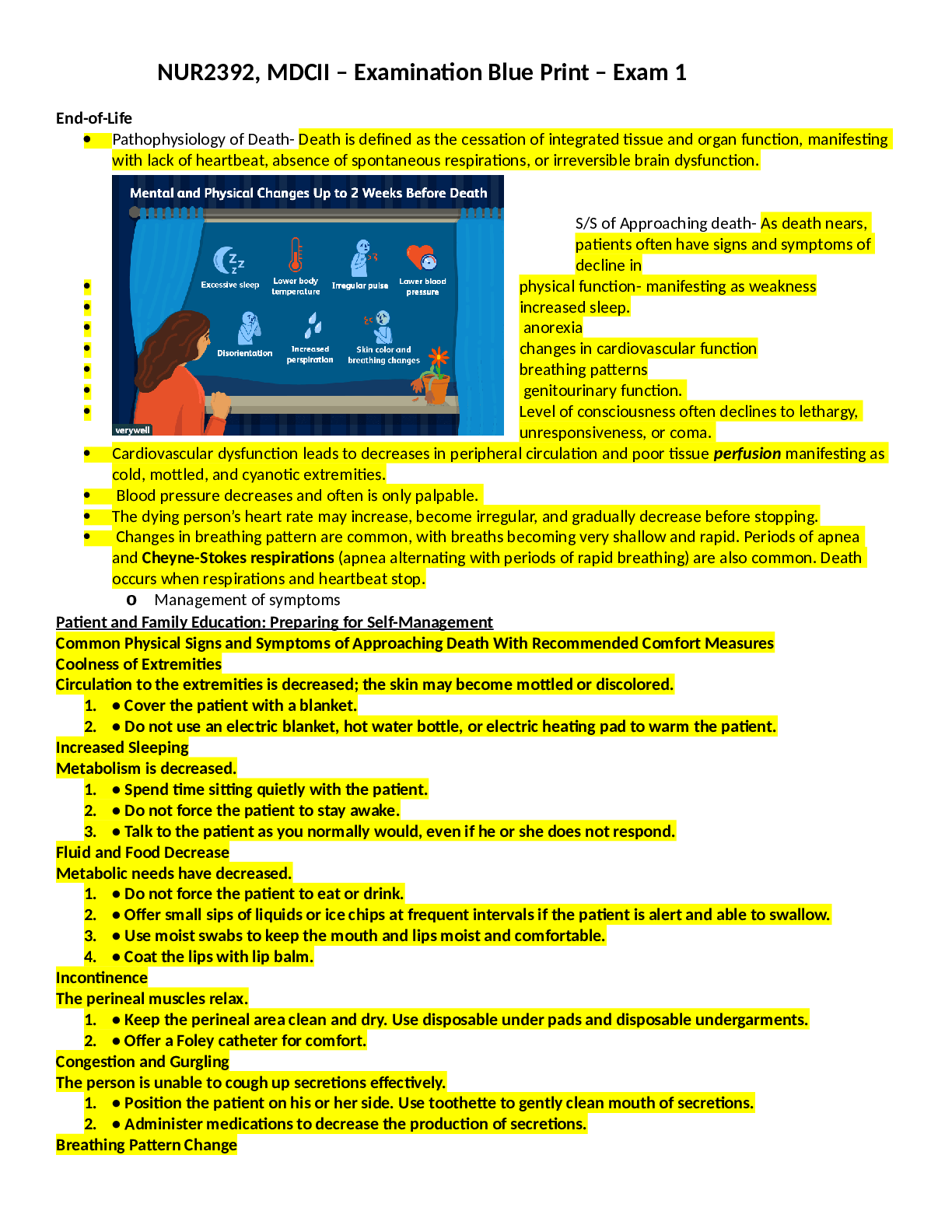
 (1).png)


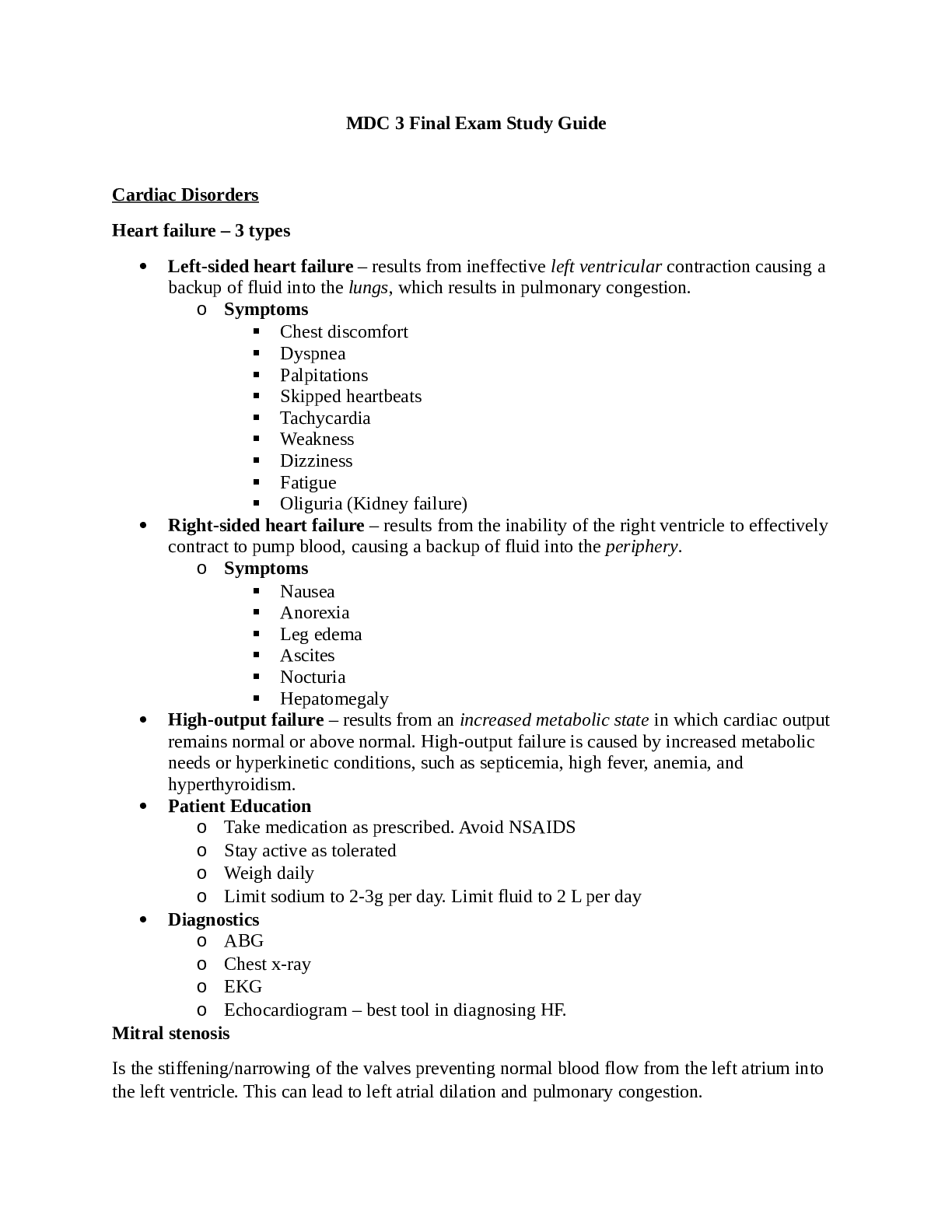
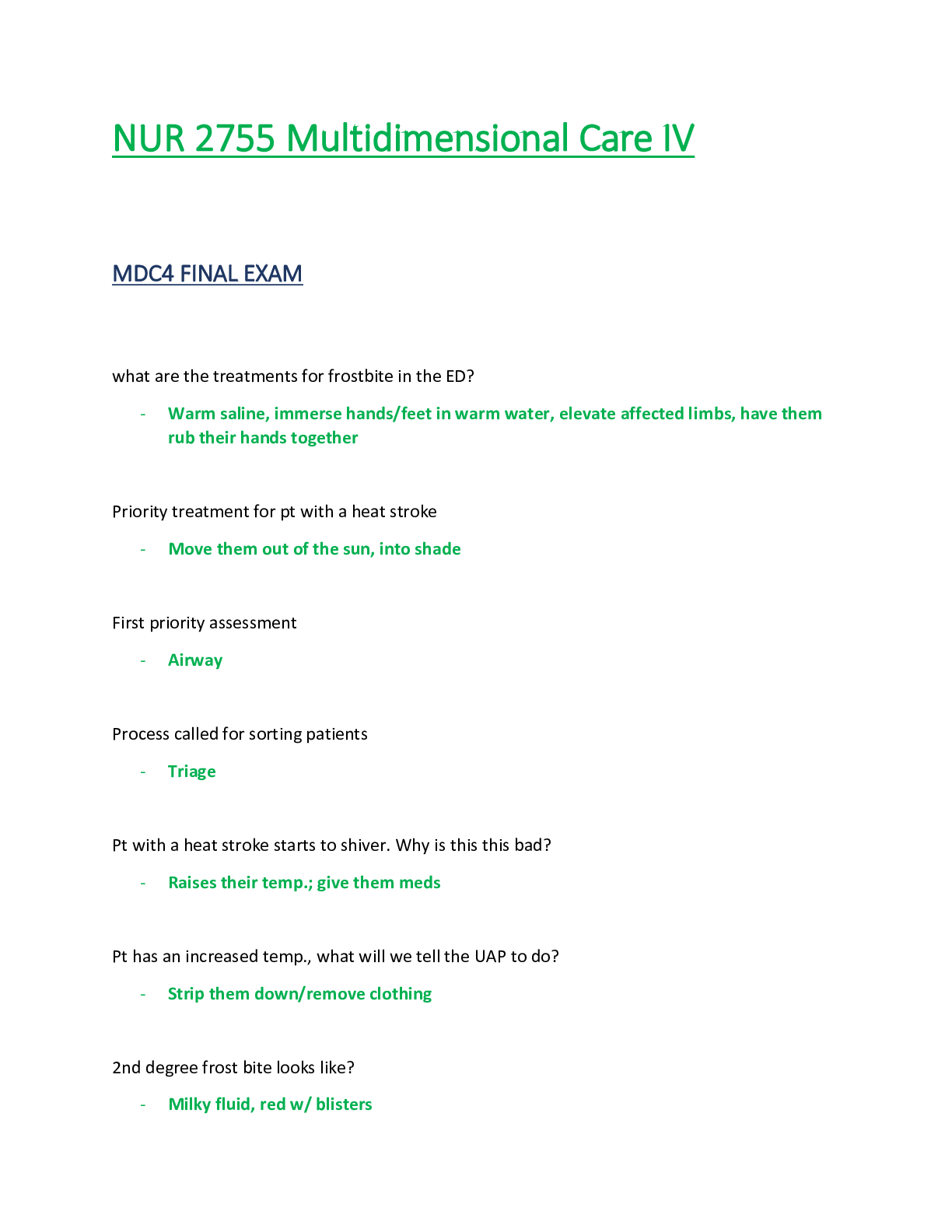
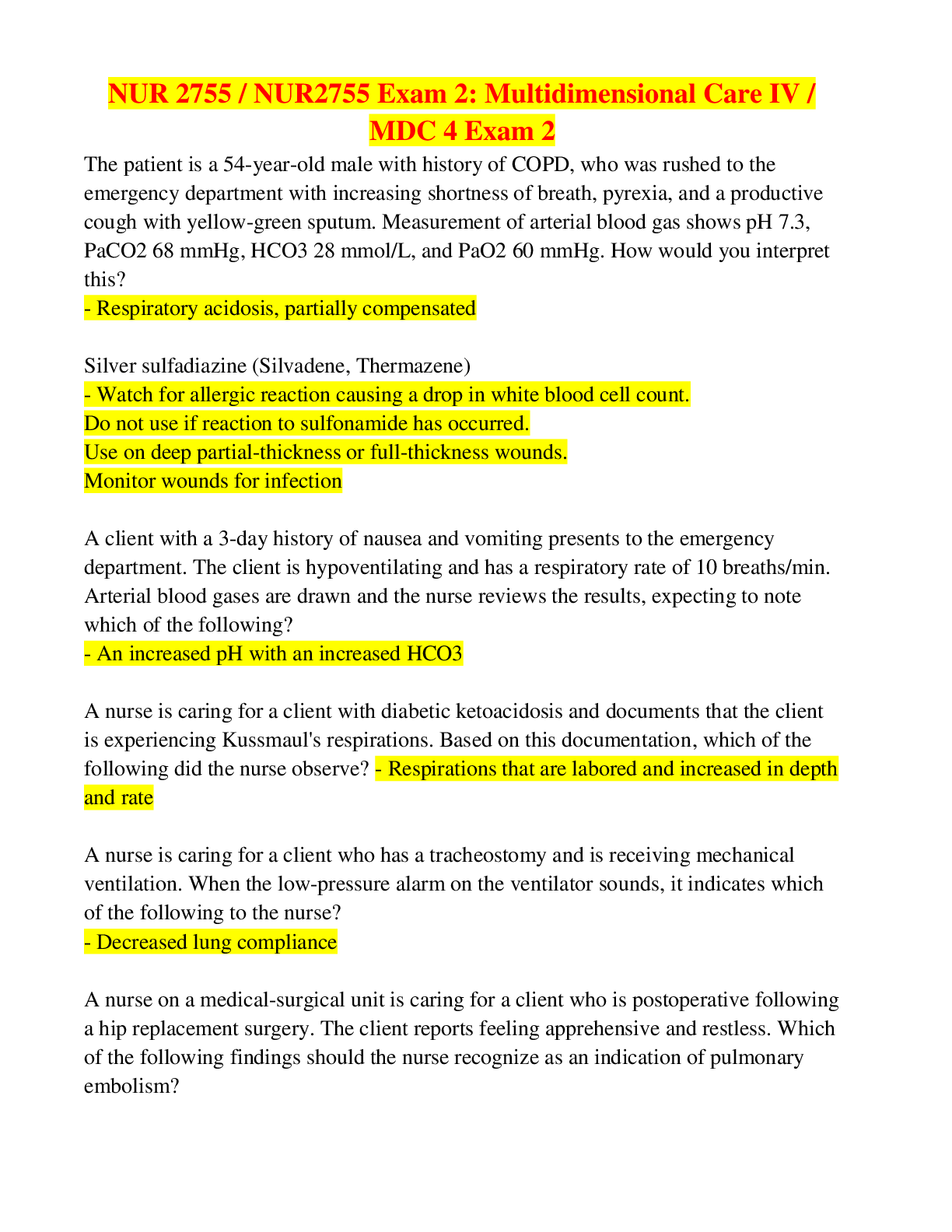

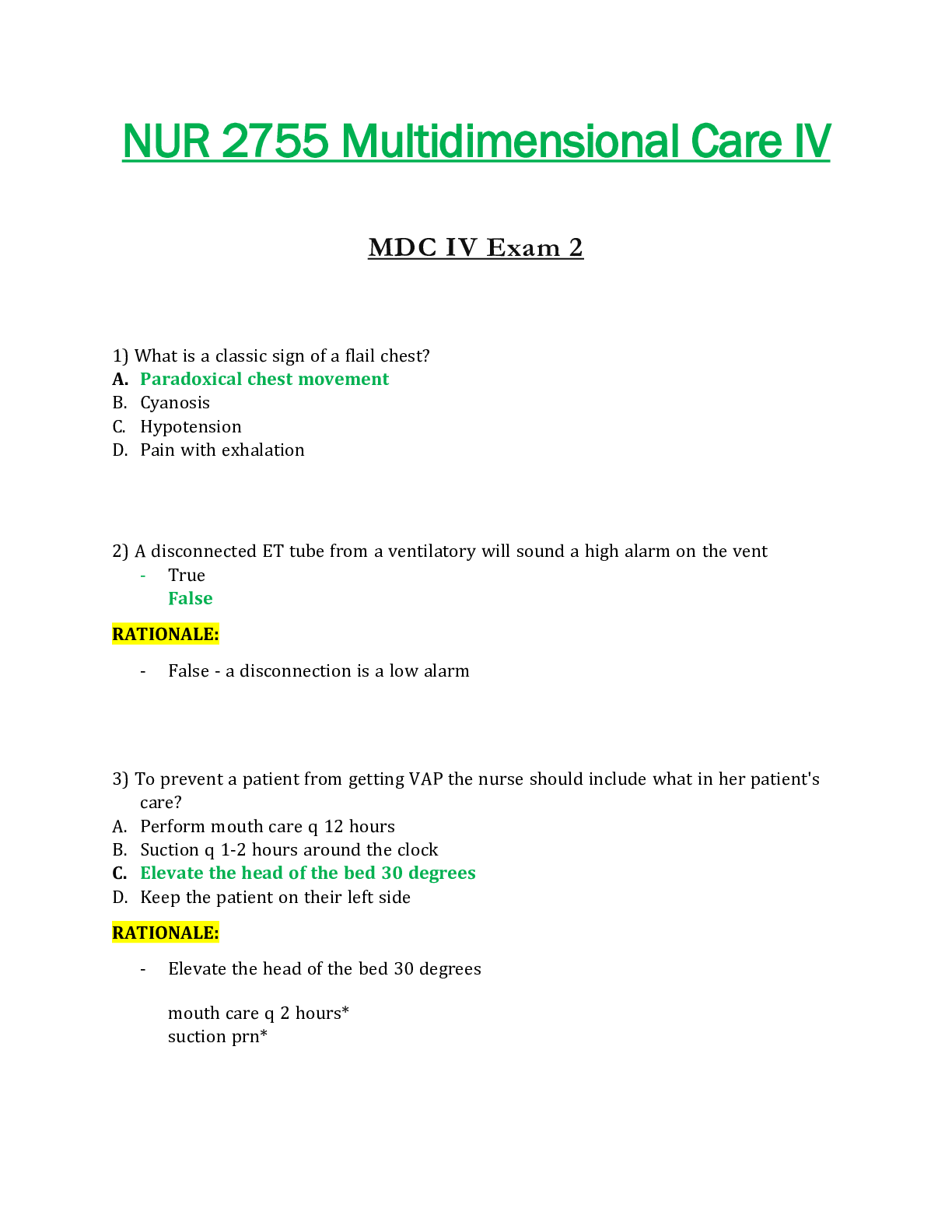
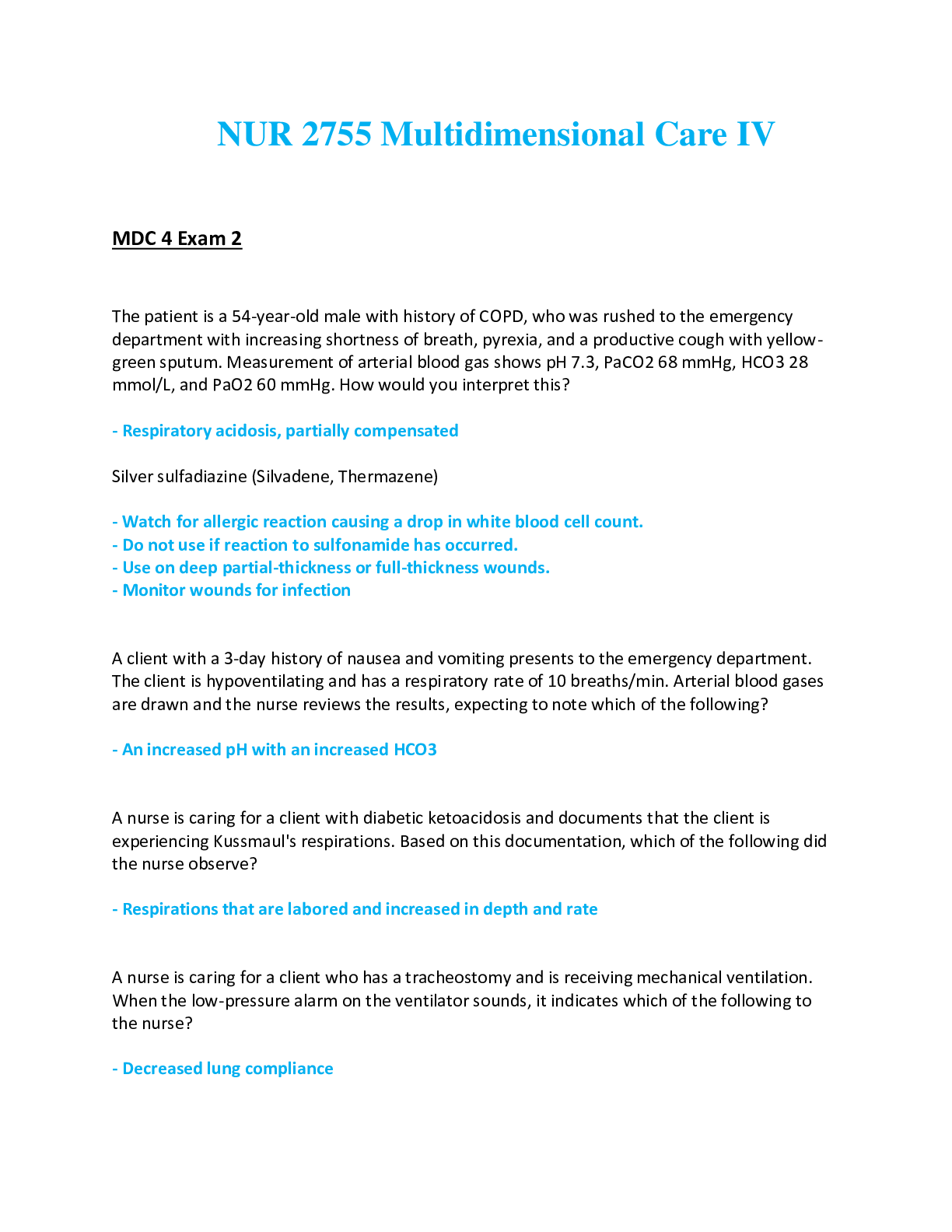
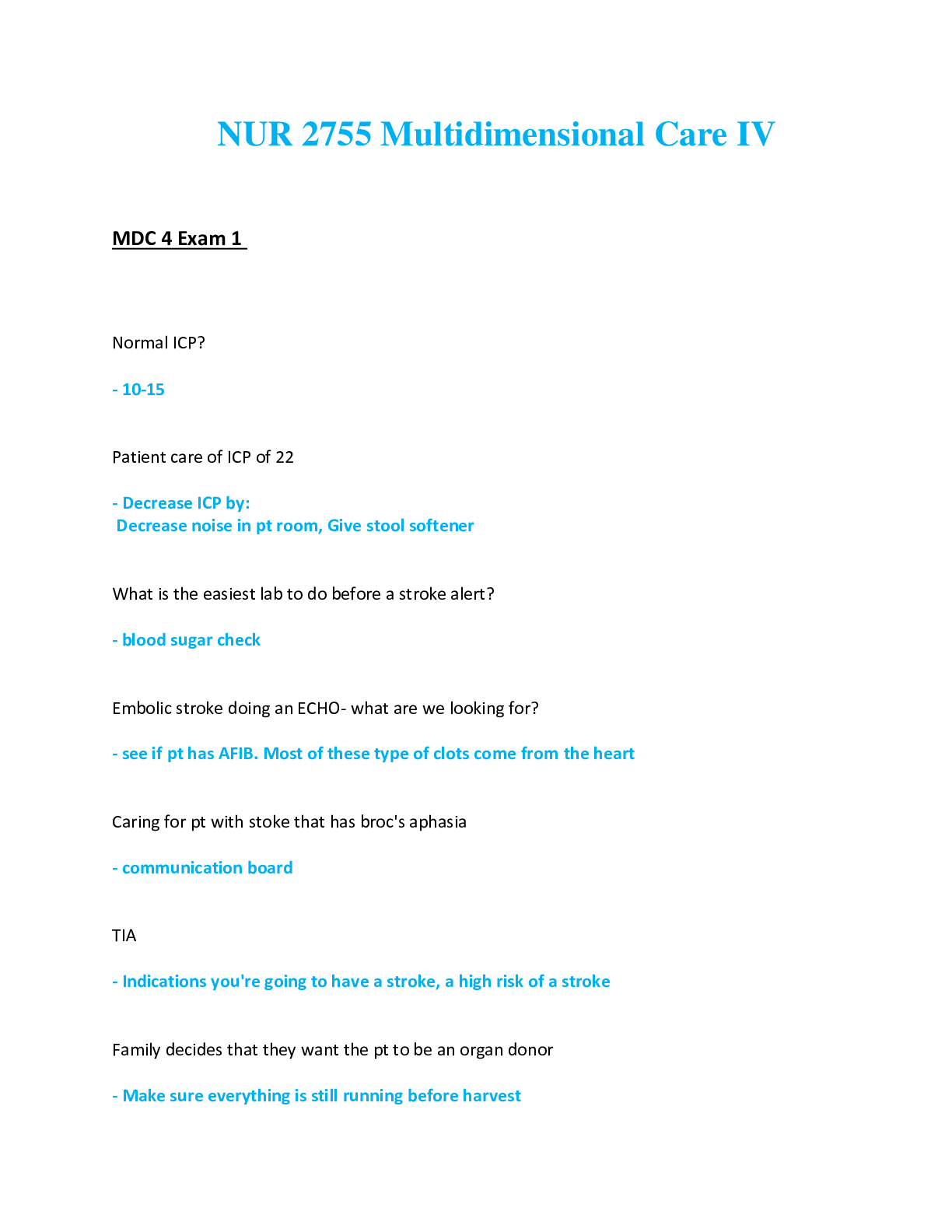
 Rasmussen.png)


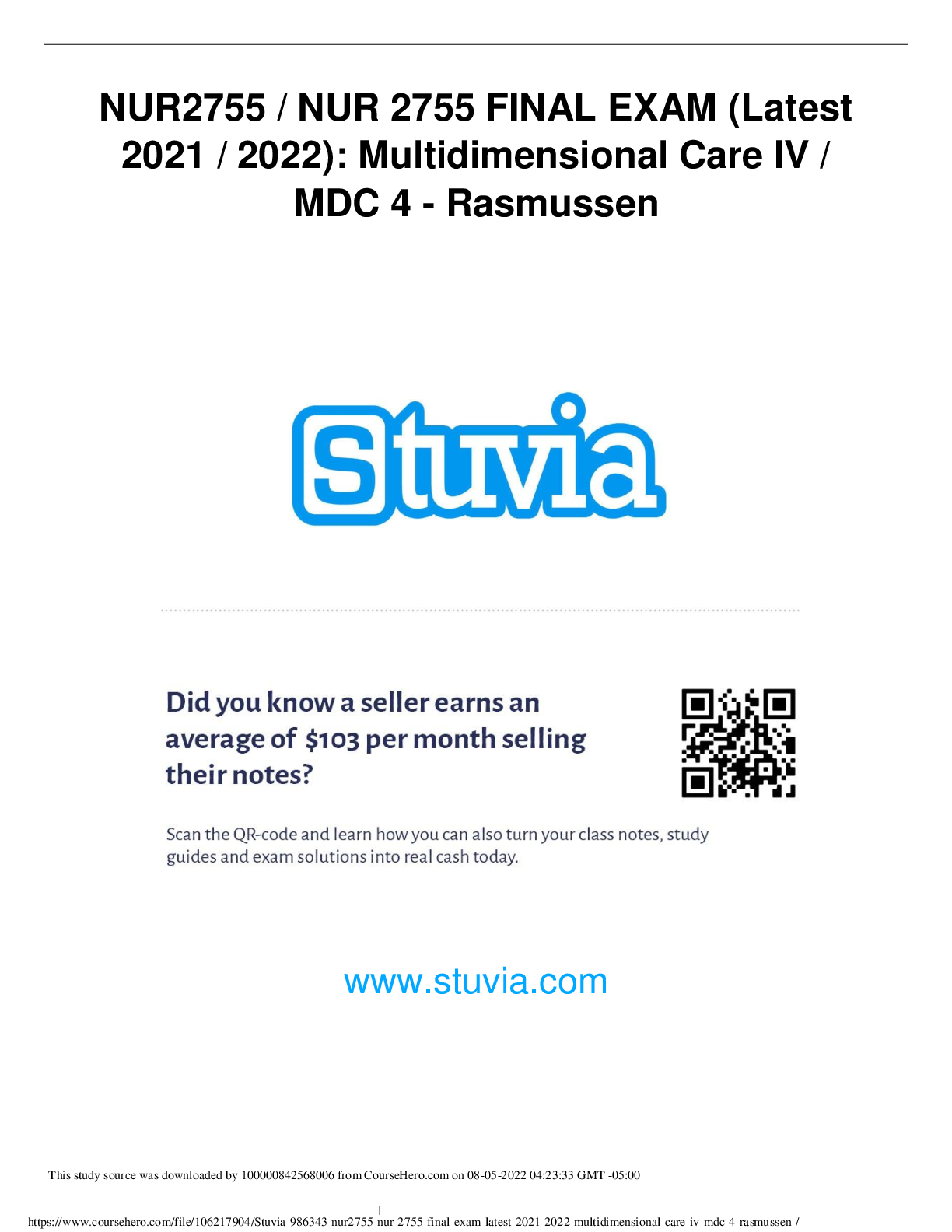
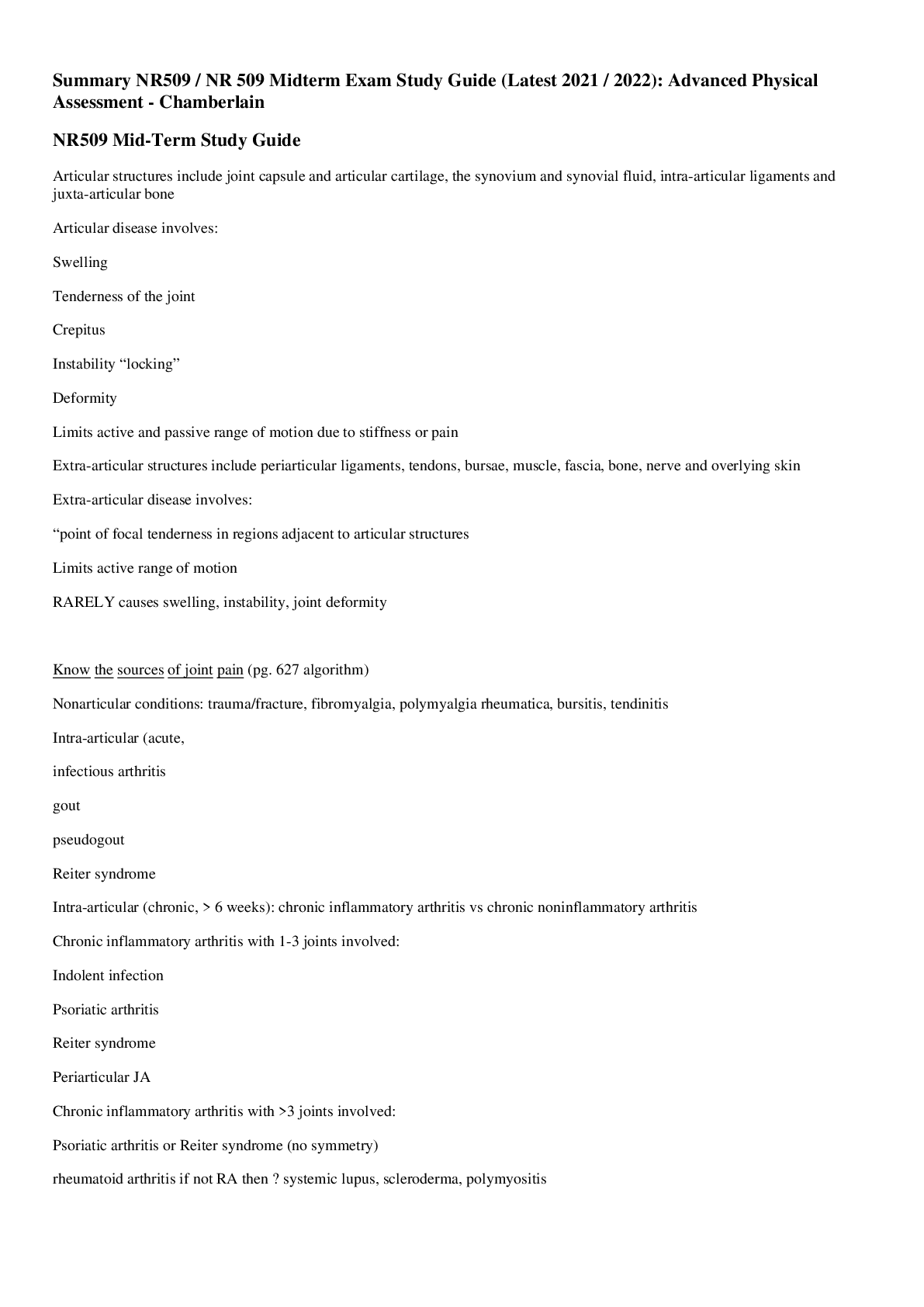
.png)
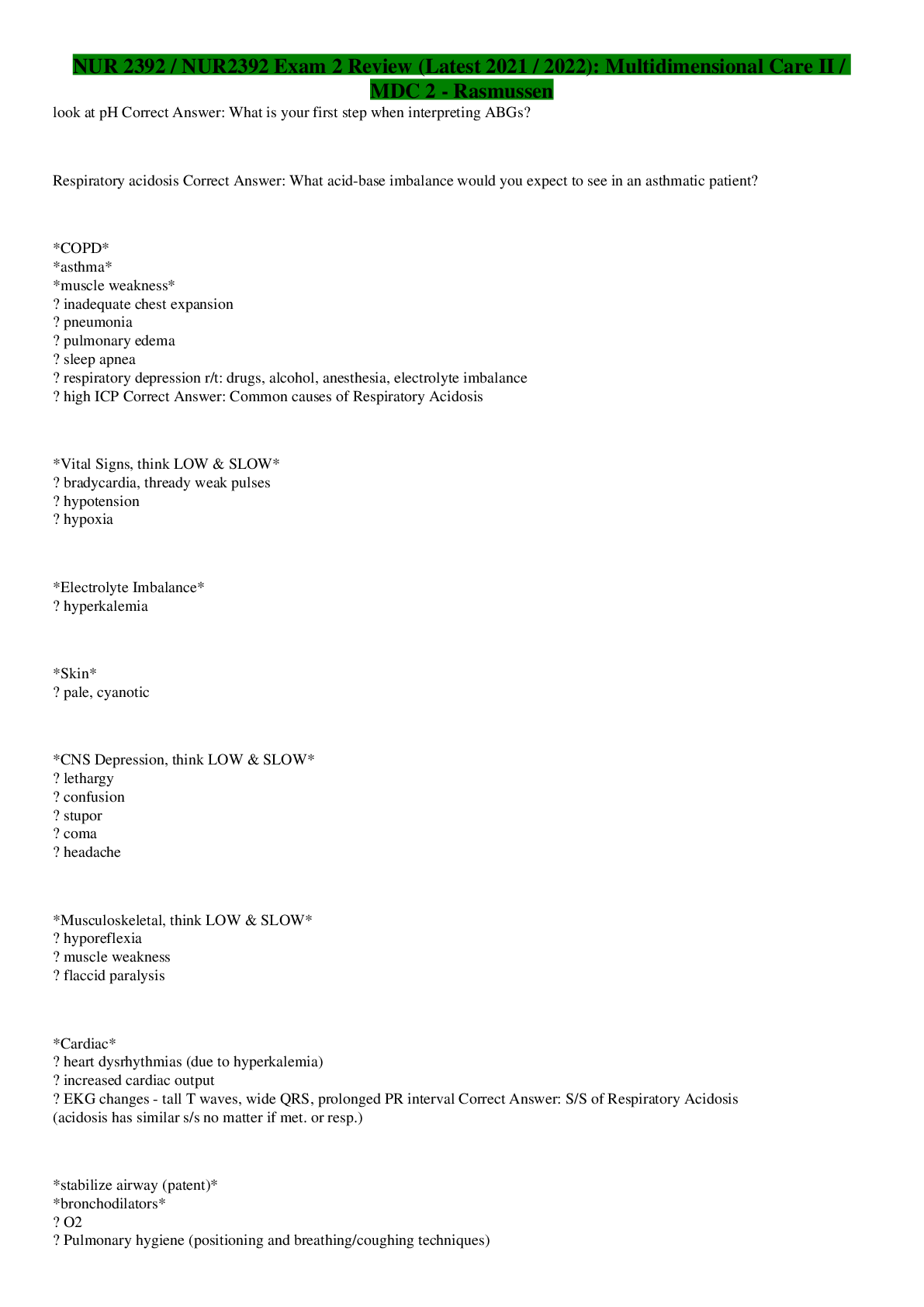
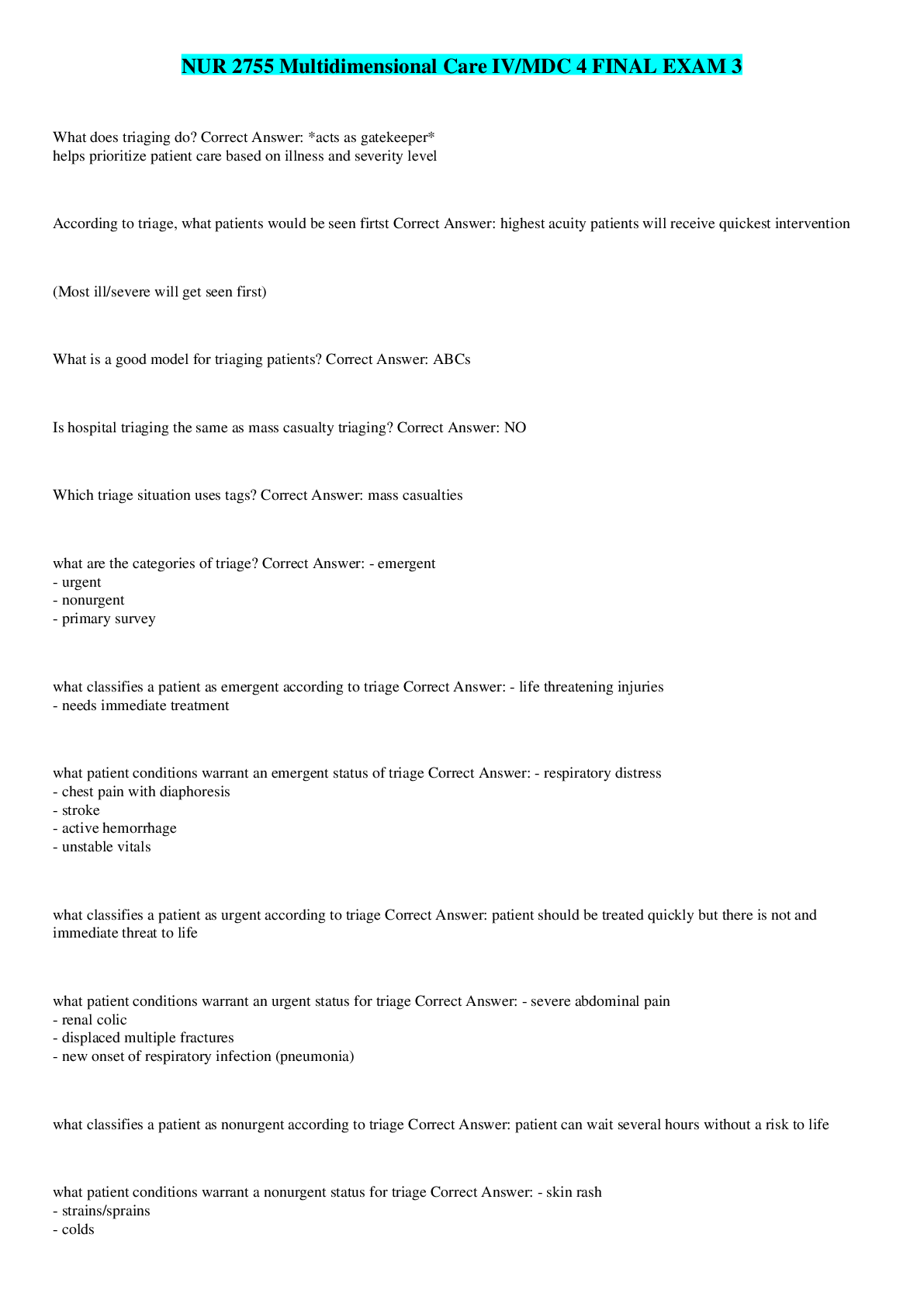
.png)
